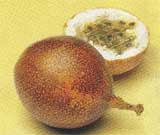|
|

Passion Fruit
|
 |
The passion fruit is round to oval, either yellow or dark purple at
maturity, with a soft to firm, juicy interior filled with numerous
seeds.
The fruit is both eaten and juiced; passion fruit juice is often added to other fruit juices to enhance the aroma. |
The two types of passion fruit have clearly differing exterior
appearances. The bright yellow variety of passion fruit, which is also
known as the Golden Passion Fruit, can grow up to the size of a
grapefruit, has a smooth, glossy, light and airy rind, and has been
used as a rootstock for the Purple Passion Fruit in Australia.
The dark purple passion fruit is smaller than a lemon, though it is
less acidic than the yellow passion fruit, and has a richer aroma and
flavor.
Smooth, leathery skin gradually wrinkles as the fruit ripens; fully
ripe fruit looks like a small, wrinkled, purple-brown ball and sounds
slushy when shaken. Cut in half to scoop out the fragrant, sweet-tart,
yellowish flesh and small, dark edible seeds. Delicious mixed with
other fruit such as cubed pineapple, or sweetened with a little sugar,
honey or liqueur and used as a sauce for ice cream, rice pudding and
custards.
Fresh passion fruit is high in beta carotene, potassium, and dietary fibre. Passion fruit juice is a good source of ascorbic acid (vitamin C), and good for people who have high blood pressure.
Some research is showing that purple passion fruit peel may help with
controlling asthma symptoms. The fruit contains Lycopene in the mature
and immature pericarp.
In New Zealand and Australia,
where it is called "passionfruit", it is available commercially both
fresh and tinned. Fresh passionfruit is eaten for breakfast in the
Summer months, is added to fruit salads, and fresh fruit pulp or passion
fruit sauce is commonly used in desserts, including as a topping for Pavlova
(a regional meringue cake) and ice cream, a flavouring for cheesecake,
and in the icing of vanilla slices. A passionfruit-flavoured soft drink
called Passiona has also been manufactured in Australia for several
decades.
In Hawaii, passion fruit is locally called lilikoi and
and comes in yellow and purple varieties. Passion fruit can be cut in
half and the seeds scooped out with a spoon. Lilikoi-flavoured syrup is a
popular topping for shave ice. It is used as a desert flavoring for
malasadas, cheesecakes, cookies, ice creammochi.
Passion fruit is also favoured as a jam or jelly, as well as a butter.
Most passion fruit comes from backyard gardens or is wild-collected.
While it can be found at farmers' markets throughout the islands, fruits
are seldom sold in grocery stores.
In
Brazil, passion fruit mousse is a common dessert, and passion fruit
seeds are routinely used to decorate the tops of cakes. Passion fruit
juice is also very common. When making Caipirinha (national cocktail of
Brazil), it is common to use passion fruit instead of lime; it is then
called "caipifruta de maracujá". It is also used as a mild
sedative, and its active ingredient is commercialized under several
brands, most notably Maracugina.
|
|
|
|
|
 |
| Email this info to Friend |
 |
Browse Pages
|
 Breads & Related Breads & Related
 Cakes & Related Cakes & Related
 Cookies Cookies
 Amazing Pies Amazing Pies
 Pastries Pastries
 Puddings Puddings
 Eggs Eggs
 Fruit Fruit
 Rice Rice
 Vegetarian Vegetarian
 Tasty Dips Tasty Dips
 Dressings Dressings
 Soups
& Related Soups
& Related
 Cooking With Kids Cooking With Kids
 Herbs & Spices Herbs & Spices
 Special Occasion Special Occasion
 Miscellaneous Miscellaneous
 Recommended Products Recommended Products |
 |
Did You Know?
|
There is a prevailing notion that the free use of fruits, especially in
summer, excites derangement of the digestive organs. When such
derangement occurs, it is far more likely to have been occasioned by the
way in which the fruit was eaten than by the fruit itself. Perhaps it
was taken in an excessive amount at the end of a meal. It may have been eaten
in combination with rich, oily foods, pastry, strong coffee, and other
indigestible viands, which, in themselves, often excite an attack of
indigestion. Possibly it was partaken of between meals, or late at
night, with ice cream and other confections, or it was swallowed without
sufficient mastication. Certainly, it is not marvelous that stomach and
bowel disorders do result under such circumstances. The innocent fruit,
like many other good things, being found in "bad company," is blamed
accordingly. An excess of any food at meals or between meals, is likely
to prove injurious, and fruits present no exception to this rule.
Fruit
taken at seasonable times and in suitable quantities, alone or in
combination with proper foods, gives us one of the most agreeable and
healthful articles of diet. Fruit, fats, and meats do not affiliate, and
they are liable to create a disturbance whenever taken together.
|
 |
|



